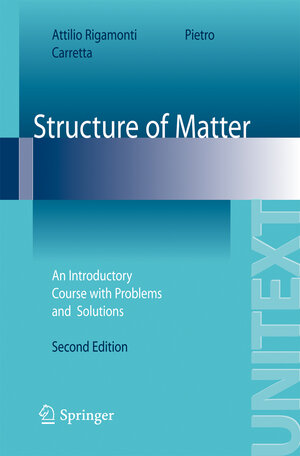
×
![Buchcover ISBN 9788847011298]()
From the reviews:
„This highly recommended textbook builds bridges between elementary physics and research activities. Its main strength lies in its mixture of simplified theory in the main text and deeper exploration in the solved problems. It addresses key concepts and typical aspects of atoms, molecules and solids. … The numerous graphs and problems with solutions make this book particularly useful for self-studying an extremely wide scope of the structure of matter.“ (Peter Enders, Optics and Photonics News, February, 2008)
Structure of Matter
An Introductory Course with Problems and Solutions
von Attilio Rigamonti und Pietro CarrettaIntended Audience, Approach and Presentation This text is intended for a course of about four months for undergraduate students. Itarisesfromtheadaptationandtheamendmentstoatextforafu- yearcourseinStructureofMatter, writtenbyoneoftheauthors(A. R. )about thirty years ago. At that time only a few (if any) textbooks having the suited formforintroductiontothebasicquantumpropertiesofatoms, moleculesand crystalsinacomprehensiveandinterrelatedway, wereavailable. Alongthelast twentyyearsmanyexcellentbookspursuingtheaforementionedaimhavebeen published (some of them are listed at the end of this preface). Still there are reasons, inouropinion, toattemptafurthertextdevotedtothequantumroots of condensed matter properties. A practical aspect in this regard involves the organization of the studies in Physics, after the huge scienti? c outburst of the varioustopicsoffundamentalandtechnologicalcharacterinrecentdecades. In most Universities there is now a ? rst period of three or four years, common to all the students and devoted to elementary aspects, followed by an advanced program in more specialized ? elds of Physics. The di? cult task is to provide a common and formative introduction in the ? rst period suitable as a basis for buildingupmoreadvancedcoursesandtobridgetheareabetweenelementary physics and topics pertaining to the research activities. The present attempt towards a readable book, hopefully presenting those desired characteristics, essentially is based on a mixture of simpli? ed institutional theory with solved problems. The hope, in this way, is to provide physical insights, basic culture and motivation, without deteriorating the possibility of advanced subsequent learning. Organization Structure of Matter is such a wide ? eld involving so many subjects that a ? rsttaskisto? ndawaytocon? neanintroductorytext. Thepresentstatusofthat VI Preface discipline represents a key construction of the scienti? c knowledge, possibly equated only by the unitary description of the electromagnetic phenomena.



